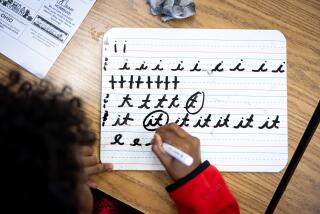Shunned Block-Play Method Now Revived in Some Schools
- Share via
Shirley Levine has always believed that blocks are more than just child’s play.
In the late 1960s, while other grade school teachers were throwing out boxfuls of wooden blocks that had been used to teach a generation of children, Levine was stockpiling them in her classroom cabinets.
And while other teachers in the Los Angeles Unified School District returned to pencil and paper methods, Levine continued to use the blocks in her classroom.
Levine thought block play was the best method of creating a stimulating learning environment for children in the lower grades. And in 1972, when she became director of Heschel Day School in Granada Hills, her strong conviction led to block play being added to that school’s curriculum.
Once Widely Used
It was a move that helped to keep alive what was a controversial teaching method in Southern California. Today Heschel is one of only a handful of schools that employ the blocks that were used widely throughout the Los Angeles schools for almost three decades. They are also used in Westland School in Calabasas.
Levine, a former consultant for the district, thinks her former employer made a mistake in giving up the block-play teaching method.
“Children sitting at desks with paper and pencil impresses lay people, but educators know that it isn’t the only way to teach young children,” she said. “Children learn through a variety of ways. Floor blocks allow them to learn in a more child-oriented way.”
Blocks were used extensively as a teaching tool in elementary classrooms throughout the nation from the 1940s through the ‘60s.
Instructional methods like block play grew out of the Progressive Education Movement that developed in the United States in the early part of this century. Progressive educators, led by John Dewey and Harold Rugg of Columbia University’s Teachers College, called for abandonment of rote memorization and drill-teaching techniques. They encouraged educators to replace these methods with group projects and activities.
The blocks are sand-colored, range in size from 3 to 10 inches long and 3 to 5 inches wide and come in squares, rectangles, cylinders and arches.
Those who attended Los Angeles-area public schools in the heyday of blocks can remember using them to build communities filled with fire stations, zoos, harbors, airports and residential areas. To make their towns as realistic as possible, children added their own hand-lettered street and traffic signs.
When the towns were completed, the youngsters acted out real-life situations such as the fire department responding to a fire.
Teachers then structured math, reading, writing, social studies and geography lessons to complement the childrens’ dramatic play.
This same methodology is used today at Heschel. Recently, a group of Heschel kindergartners entered the school’s block-play room ready for an hour of academic play.
As soon as the door to the empty room opened, youngsters dashed in and pulled scores of blocks from the shelves. Then, working in teams of twos and threes, the youngsters began building their community.
Teacher Susan Goldman discovered two boys building the town airport. They had placed the control tower in the middle of the terminal. Goldman escorted the two architects to a large photo file where they looked at pictures of airports.
“The tower belongs near the runway,” one of the boys squealed in delight.
“That’s right,” Goldman said. “Now, go back and correct it.”
After the Heschel kindergartners completed their town, Goldman took the group to each structure so they could evaluate the work. The youngsters pointed out the good things--such as having a special exit in the zoo so animals could leave quickly in case of a fire. They also were quick to spot faulty logic, such as the block house that had no windows or doors.
Later in the day, Goldman had the children tell her stories about their construction experiences. As they talked, she sat at a typewriter and typed out their sentences. In a matter of moments, the children had “written” their own story about the community they created.
“This kind of structured play sparks a child’s innate curiosity and creates a natural desire for lessons in math, reading, writing, geography and history,” Levine said.
More to Read
Sign up for Essential California
The most important California stories and recommendations in your inbox every morning.
You may occasionally receive promotional content from the Los Angeles Times.













